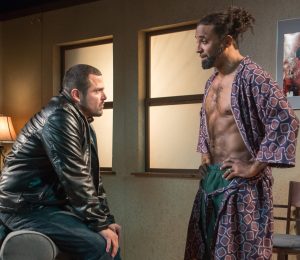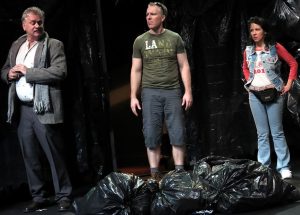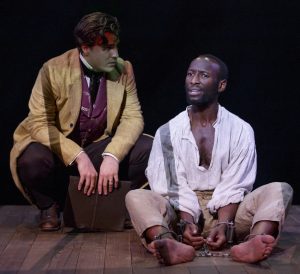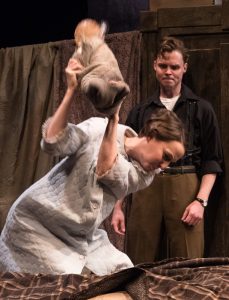Ardor, the fourth play by playwright and director Matthew Gasda, reflects an impressive literary talent. Gasda has given the actors in his new ensemble drama material that is raw, fresh, honest, poetic, deep, daring and, clearly, a joy to perform. Their conversations are at once innocent and knowing, as well as both painfully cutting and a pleasure to hear.
Sagittarius Ponderosa
MJ Kaufman’s latest play, Sagittarius Ponderosa, tells the story of a young man returning home to help take care of his ailing father. The play, staged by the National Asian American Theatre Company (NAATCO), begins at a Thanksgiving dinner with the young man, his father and mother, and his grandmother expressing what each is grateful for. This opening scene is telling. On one hand, it’s a precursor to many familiar stories: a young person returning home attempting to make his way in the world, and his struggle with sexuality, love, and attachment; a child taking care of an elderly parent; a wife coming to terms with the eventual death of her husband; a grandmother’s struggle with hearing issues, and, more important, her desire to see her grandchild married. Even though Kaufman sets Sagittarius Ponderosa squarely within an Asian-American family, each of these stories is universal.
The Resistible Rise of Arturo Ui
It’s a turning point in American history when a candidate for President suggests, ominously, that should the election not go his way, he will not go quietly into the good night of a peaceful transition of power. Bertolt Brecht’s sprawling farce The Resistible Rise of Arturo Ui is a piercing look at the rise of a thug and petty tyrant whose lessons will not be lost on viewers in this election season. Written in a mere three weeks in 1941, the play is Brecht’s effort to radically deflate the mystique, worship, and awe that despots typically inspire. Joseph Goebbels, the Nazi Minister of Propaganda, viewed his creation of the myth of the Führer as his greatest achievement, an achievement that made possible Adolf Hitler’s consolidation of power even as he was curtailing civil liberties and murdering real and perceived threats to his power. Brecht’s weapon of choice: humor!
Coriolanus
The playbill for the Red Bull production of Shakespeare’s rarely staged Coriolanus gives the time period as "Rome, 493 B.C.E. Here, now." But, under Michael Sexton’s direction, the latter prevails: military men in camouflage fatigues and dress greens, a First Citizen with a T-shirt that reads “You can’t have capitalism without racism,” and several female soldiers all declare it’s now. There’s virtually nothing identifiable from 493 B.C.E.
Addictions of the City
The characters are lively, the language is crisp and urban, and the acting is skilled in Stephen Adly Guirgis's The Motherf**ker with the Hat. The energy of classic salsa music in the house helps pump up the energy at T. Schreiber Theatre’s exciting production. Guirgis’s unabashedly vulgar play explores themes of love, morality and choice in one of the most diverse cities in the world, New York. His characters, although primarily of Puerto Rican extraction, encompass the multiple ethnicities of the city. Most are plagued with addictions and afflictions that raises the stakes of their every move. The play, one of Guirgis’s best, is both hilarious and thought-provoking.
It starts with a high energy-conversation. Veronica (Viviana Valeria) is on the phone with her mother, who has an addiction to alcohol; Veronica dislikes her mother’s fish-faced boyfriend and tells her, “You’re dating a “fuckin’ big-time loser with a head like a actual fuckin’ fish! …Ma, when you see him tonight: Take a moment. Take a breath. Take a real good look and just ax yourself in all honesty—‘Do I wanna fuck him—or fry him up with a little adobo and paprika...?’”
Wrapped around the jokes and comic dialogue lies the issue of coping, or rather, surviving. Guirgis’s characters are struggling with heavy substance abuse and making it one day at a time. Each day is a journey for them. They include Jackie (Omar Bustamante) who enters with flowers in his hands and greets Veronica with enthusiasm and love. He chants a rhythmic “These flowers are for my Beautiful Boriqua Taino Mamacita Love Me Long Time Princess fuckin’ Beauty Queen.” Having just landed a job, Jackie wants to celebrate. He begins talking about their future, possible promotions—their life together. Still, Veronica is having trouble getting clean..
While Veronica takes a shower, Jackie finds a hat—a hat he knows does not belong to him. He smells the bed and pillows. He then asks Veronica, “Why the bed smell like Aqua Velva and dick?” But Veronica denies any infidelity and tries to calm him down by suggesting they go eat some pie. (That’s right, pie.) He reluctantly agrees.
Ralph D (Casey Braxton) is another one of the conflicted characters in the play. As a sponsor, he is guiding Jackie on the path to sobriety. Yet he is also the cause of Jackie’s fall. Ralph D has had an affair with Veronica while Jackie was in jail. Although Ralph D cares about Jackie, he has completely betrayed him. Ralph D has stayed “clean” from his additions, but he is not "clean" morally or ethically. Victoria (Jill Bianchini) and Jackie try as well, but inevitably fall off the wagon.
Among the charismatic, enigmatic characters is also Cousin Julio (Bobby Ramos). Julio helps Jackie hide a gun that he has used to threaten the man he thought was the owner of the hat. “Leave the gun. Take the empanadas,” he advises, in one of many comic lines. Julio is a delicious dichotomy of a character. Humorous and deep, he values family and is brutally honest, and Ramos’s performance is a crowd-pleaser.
Director Peter Jensen keeps the production’s energy high, and scenic designer Miguel Urbino uses sets that are minimal yet functional. They resemble an urban setting that captures the lives of these characters. Sound designer Andy Evan Cohen provides a taste of the urban Latino scene in New York City with salsa and hip-hop playing between scenes and during intermission—including “So Fresh and So Clean” by Outkast and classics by Hector Lavoe.
The Motherf**er with the Hat is a production you won't want to miss.
The Motherf**er with the Hat plays through Nov. 19 at T. Schreiber Theatre (151 W. 26th St.) Evening performances are at 8 p.m. Wednesday through Saturday; matinees are at 2 p.m. Nov. 9 and 16. Tickets are $20 for general admission; $30 for reserved seating; $40 for dinner plus VIP reserved seating. For more information, call (212) 352-3101 or visit tschreiber.org. The production contains graphic language.
Template for an Epidemic
The adventurous Playhouse Creatures Theatre Company is offering what’s labeled a “20th anniversary production” of Naomi Wallace’s One Flea Spare. This mordant historical drama didn't actually arrive in New York until 1997. It was a critical favorite at the 1996 Humana Festival of New American Plays in the playwright's hometown, Louisville, Ky.; and word of mouth from the Festival made its subsequent engagement at the Joseph Papp Public Theater one of the most anticipated events of the theater season. One Flea Spare, which derives its title from a poem by John Donne, is set in 1665 and portrays four people—a married couple and two strangers—trapped in a house that’s under quarantine. The place is the London of Daniel Defoe’s AJournal of the Plague Year, a work of fiction, which, Wallace has said, inspired the imaginative universe of her play. The current revival, directed by Caitlin McLeod and performed by a fine quintet of actors, is two relentless hours of powerful, if markedly cerebral, dialogue, with a number of narrative surprises for the first-time viewer.
Wallace wrote One Flea Spare in the midst of the AIDS epidemic, a public-health crisis that profoundly affected the American and British theater communities (and continues to do so). At that point, those infected with HIV had little expectation of longevity and those living with AIDS were subject to prejudice and a myriad of injustices. Defoe’s great novel and its portrait of plague-ravaged London was a natural point of historical reference for an erudite writer contemplating modern men and women contending with the spread of inexplicable disease.
In One Flea Spare, William and Darcy Snelgrave (Gordon Joseph Weiss and Concetta Tomei) are childless aristocrats whose home has been quarantined after the death of their servants from bubonic plague. Just as the Snelgraves are about to be released from forced isolation (which would allow them to flee London for the peace and presumed safety of the countryside), their premises are invaded by Bunce (Joseph W. Rodrigues), a virile, coarse-mannered sailor, and Morse (Remy Zaken), a 12-year-old servant disguised as the daughter of the upper-crust family whom she previously served. Both are seeking asylum from infection and the police.
The interlopers are a catastrophe for the Snelgraves. A municipal guard (Donte Bonner), charged with monitoring neighborhood compliance with hygiene regulations, sees them, bars the residence doors, and extends the quarantine. This means that four people from differing social strata of a rigidly hierarchical society must endure 28 days together in the closest quarters imaginable. As the play proceeds, the high-testosterone presence of Bunce unsettles the sex-starved Snelgraves and awakens unaccustomed responses in the pubescent Morse. Under stress of confinement, the characters' secrets and prejudices slip out, their yearnings boil up, and civility evaporates in the heat of compulsive drives and desires.
Scenic designer Bryce Cutler has configured the Sheen Center's black-box venue for intimate theater-in-the-round, with minimal space between actors and audience. The principal feature of his simple, handsome stage set is a tiny, raised platform on which the bulk of the action is played. Four of the five actors are crowded in that little square for much of the performance, while Bonner, playing the sole character not confined to the house, wanders around outside the square, addressing the other actors from a lower level that represents the street.
Sarafina Bush dresses the actors in drab-hued costumes that combine contemporary garments with items suggesting 17th-century style. Aaron Porter illuminates the stage in cold, wintry light. The effect of the creative team's design is a sense of unrelenting claustrophobia.
Wallace is an artist of extremes. Her characters are altruistic one minute, predatory the next. The dialogue veers precipitously from poetic to crass and profane. The effect of her prose is as often chilly as it is sensual. Her writing often soars with an operatic quality, fraught with emotion, that captures the characters’ sexual longing yet expresses the trauma created by their radical separation from the rest of the world. McLeod has staged the play with a great deal of dance-like movement that complements the musicality of Wallace’s text and depicts the play's eroticism and violence vividly but with a certain delicacy. Despite occasional lapses in dialect, the five actors handle the lyrical qualities of the playwright's lines and speeches effectively and function throughout as a balanced ensemble.
When One Flea Spare premiered at the Humana Festival, Wallace had already made a name for herself in Britain but was unfamiliar in her native land. During the past two decades, she has become well-known, at least for a playwright, in the United States. She has received a "genius grant" from the John D. and Catherine T. MacArthur Foundation (possibly the most enviable honor in the English-speaking world); and, since 2009, One Flea Spare has been the sole work by a living American author in the repertoire of the Comédie-Française, the French national theater. The current revival makes a strong case for One Flea Spare as the original, insightful work the critics judged it to be 20 years ago in Louisville and an enduring part of postmodernist drama.
Naomi Wallace’s One Flea Spare plays at the Sheen Center (18 Bleecker St.) through Nov. 13. Evening performances are at 8 p.m. Wednesday through Saturday; matinees are at 2 p.m. Saturdays and 3 p.m. Sundays. Tickets may be purchased by calling the box office at (212) 925-2812 or visiting sheencenter.org/shows/one-flea-spare/.
Is Now Really the Time?
Any time theater requires backstory and more research after the curtain drops, it dances a fine line between “Wow, that was interesting. I want to know more” (if you’re lucky) and (more often than not) “What the hell did I just see?” Little Lord is a Brooklyn-based company whose previous works have been praised as “scrappy creative brilliance” or “fearless in ... weirdness.” Now Is the Time. Now Is the Best Time. Now Is the Best Time of Your Life is its latest undertaking, and the show clearly falls in the second category—fearless and weird.

The Little Lord production team sets the tone for a fun and crazy evening with free pickles and coleslaw, offering $4 beer by folks dressed like deli workers and a Mistress of Ceremonies, straight out of Hairspray, even before the “curtain” goes up. Truth be told, the only thing that resembles a curtain is an iridescent panel of foil strips at the back of the stage. Just in time for Halloween, Now Is the Time is a perfect occasion to reimagine Washington Irving’s story of Rip Van Winkle, provided you are one of the few who remembers it! Between the Diedrich Knickerbocker character, a Rip Van Winkle character (oddly, played by a woman), six actors dressed up as freaky yard gnomes, and that Mistress of Ceremonies in a lime-green, pleated baby-doll dress (who later appears as Beelzebub), there is still never enough story to know which end is up. The six yard-gnome characters, who appear as if to taunt Knickerbocker, often repeat lines in unison from some of Knickerbocker’s books. Near the end, they return in white clothes and colorful knee-high socks, sporting black dunce caps (Karen Boyer did the wildly eccentric costumes) and carrying small, wooden children’s chairs. It is all just odd and disjointed.
The set design by Peiyi Wong resembles something out of Hoarding: Buried Alive on The Learning Channel. Stacks and stacks of books, a mountain of lawn chairs and beach balls, leftover Christmas lights, and an old library card catalog are just a few items that fill the stage. If you knew how Irving came to create the Rip Van Winkle character—who slept through the American Revolution—to somehow figure out this Rip Van Winkle awakens in the Catskills somewhere near Grossinger’s, the set might make sense. Now Is the Time has a mountain of missing information, and one more prop isn't going to help.
Director Michael Levinton, who also takes on the lead role of Knickerbocker, has a vision for Now Is the Time that never quite translates across the footlights. As Knickerbocker, he is outrageously quirky, and his delivery engaging. Written by Levinton, Laura von Holt, and Little Lord, the play tosses out interesting snippets of New York history like popcorn, but the story never develops beyond witnessing the madness of a man who dresses like a homeless King George, his nonsensical interaction with Rip Van Winkle, or his hiding from his loud, obnoxious wife who looks more like she should be singing, “Welcome to the ’60s.”
Now Is the Time features Kaaron Briscoe, David GR Brummer, Avi Glickstein, Fernando Gonzalez, Sauda Jackson, Polly Lee, Ry Szelong, and Morgan Lindsey Tachco. Each of them thoroughly embodies the characters they were given, whether they are the deli workers, freakishly odd garden gnomes, or the Children of the Corn with dunce caps. The full production includes very good sound effects by Kate Marvin, along with eerie and complex light design by Marika Kent.
If you are a devotee of Little Lord and company, Now Is the Time may be the ticket to be had. However, without more backstory and some continuity, it’s going to take a lot more than pickles and beer to clear the haze, wicked garden gnomes notwithstanding.
Now Is the Time. Now Is the Best Time. Now Is the Best Time of Your Life plays through Nov. 5 at the Abrons Arts Center (466 Grand St. at Pitt Street) on the Lower East Side. Evening performances are at 7:30 p.m. Wednesday through Saturday; matinees are at 2:30 p.m. Saturdays. Tickets are $25. For tickets and more information, visit abronsartscenter.org.
The End of Days
Adam Bock’s rueful A Life covers both the title and its aftermath. It may borrow from—or perhaps merely echo—other plays, but in 80 minutes Bock conveys the fragility of mortality and the sadness of one person’s death in a deeply affecting way. Structurally, A Life is unusual. It begins with a long monologue, as David Hyde Pierce’s Nate, a middle-aged gay man, talks about his life, his ex-boyfriends, and his interest in astrology. The monologue lasts half an hour, and it may recall the tour de force that opens Tony Kushner’s Homebody/Kabul, although this monologue dovetails more organically into what follows.
Bock’s theme is virtually identical to that of A Delicate Ship (yet the result is more powerful), the Anna Ziegler drama staged by Playwrights Realm last season at Playwrights Horizons. That took its title from W.H. Auden’s poem Musée des Beaux Arts, as the Greek figure of Icarus falls from the sky into the ocean:
“The expensive delicate ship, that must have seen Something amazing, a boy falling out of the sky, Had somewhere to get to, and sailed calmly on."
The point of Auden’s poem is Bock’s too: no matter the gravity of one person’s death, life continues in its myriad small ways, even though they pale next to the end of an existence. In the half-hour opener, Hyde Pierce is able to connect deftly to his audience with the details of Nate’s past. Obviously famous from his work on television, Hyde Pierce is a consummately skilled stage actor as well. He has a wry comic delivery, sometimes self-deprecating, sometimes bewildered, accompanied by nods of the head, hangdog eyes, pauses, repetitions and grimaces, as he relates his early life in Pawtucket, R.I.; his friendship there with a woman who got him interested in astrology; and the string of boyfriends that he has had, many of whose names rhymed: Sean, John, Ron, Johan, Jan. Every moment feels lived in and true.
Hyde Pierce’s casual yet powerful performance ensures that we come to care about Nate before his life-ending event. (Alas, it’s impossible to discuss this play without this spoiler.) Some of his friends, he says, wonder why he never paired up with Curtis (Brad Heberlee), his longtime best friend, but it’s not in the cards, Nate says. Their bond is conveyed in a lovely scene as the two friends sit on a New York City park bench and watch muscular men jog by, trading amusing expressions of admiration and frustration.
As Nate returns home, he suffers a heart attack. What follows under Anne Kauffman’s superb direction is another extraordinary bit of stagecraft. For perhaps four minutes—an eternity in stage time—nothing moves and one hears only Mikhail Fiksel’s urban soundscape outside and registers the subtle lighting by Matt Frey that indicates the passage of time.
Two scenes then pick up the thread of Bock and Auden’s theme more directly. The mortician’s office arrives to collect Nate’s body while the stricken Curtis stands by, a bit bewildered as the mortician, Jocelyn (Marinda Anderson), takes a call on her cell phone. It seems inappropriate, but it’s also true: other lives continue in all their small, messy ways even as one life ends. There are even comic moments amid the tragedy, as Jocelyn persistently mishears the phone number Curtis is trying to give her, and they go back and forth trying to get it right.
In the following scene the drama literally stops, as it does in D.H. Lawrence’s The Daughter-in-Law after the husband comes home from the mines and washes up, drawing its power from the simplicity of action. On a gurney in the funeral home, Nate’s body is prepared, as Jocelyn and her assistant comb the hair, cut the nails, and glue the lips shut—while discussing family flare-ups and inconsequential bits of botany and biology. The effect is to set in relief, amid the mundane babble, the gravity of a life lost.
Bock’s final scenes follow Nate’s funeral, Curtis’s breakdown (Heberlee’s part isn’t flashy, but he inhabits it feelingly), a speech by Nate’s sister (Lynne McCollough, who is equally good as a mousy mortician’s assistant), and a voice-over (there have been some already) from Nate. The voice-over carries the promise of something beyond. It’s a graceful and powerful ending to a simple story, brilliantly staged and presented.
Playwrights Horizons (416 West 42nd St. between Ninth and Tenth avenues) is presenting Adam Bock's A Life through Dec 4. Evening performances are at 7:30 p.m. Tuesdays through Saturdays and at 7 p.m. on Sundays. Matinees are at 2:30 p.m. Saturday and Sunday. During Thanksgiving week (Nov. 21-27), the performance schedule will be Monday, Tuesday, Friday and Saturday at 7:30 p.m., and Wednesday, Saturday and Sunday at 2:30 p.m. Tickets are $59-$99 and may be purchased by phone at (212) 279-4200 or by visiting phnyc.org.
Paris Is Yearning
Founded in 2006 by director and choreographer Austin McCormick, Company XIV has developed a signature fusion of theater, classical and modern dance, opera, drag, circus, live music, burlesque, and performance art. The title of its latest creation, Paris, is a double entendre of sorts—referring at once to the beloved City of Light as well as the legendary prince of Troy. Indeed, Paris unites Grecian gods and goddesses with Parisian flâneurs and can-can girls, resulting in an indulgent, adults-only revue of sublime talent.
Consequences of Our Actions
Can a trial change history? What happens when standards of behavior are violated and not brought to public reckoning? The Trial of an American President is a courtroom drama of a trial that will never take place, of legal arguments that will not be made, and finally, of a verdict that will also not happen, except perhaps in the court of public opinion, if the writer has his way
Ibsen as Detox
When newspaper editor Hovstad cries, "We must destroy this myth that our leaders are infallible," in the rousing performance of Public Enemy at the Pearl Theatre Company, the audience titters and sighs. That same day, the Washington Post had released a tape of presidential nominee Donald Trump making extremely lewd remarks about women. With Trump's words ringing in the collective consciousness of the audience, playwright David Harrower's adaptation of Henrik Ibsen's 1882 play An Enemy of the People has transposed an almost 150-year-old story about small-town bureaucracy to the higher, tenser key of our present-day political landscape. That is not to say that Public Enemy is toxic, exhausting or anything like the American political process has been this past year. On the contrary, it rejuvenates the public with an eloquent tale of justice and ambition.

Director Hal Brooks, who is artistic director of the Pearl, has confirmed the company's commitment to showcasing incisive, relevant classical theater with Harrower's masterly take on one of the Norwegian playwright's lesser-known plays. Written as a biting response to critics, whose moralistic reviews he despised, Ibsen deliberately set out to magnify the hypocrisy of human nature, and how it is writ especially large in political processes. He chooses to place his little human drama in a fairly provincial town, where the family of Dr. Thomas Stockmann (Jimmon Cole) and his wife (Nilaja Sun) is enjoying a life of newly-found comfort—they're on the upswing after some hard financial times.
Also in the mix are the Stockmanns' friends: fiery newspapermen Hovstad (Robert Tann) and Billing (Alex Purcell), and world-weary sailor Horster (Carol Schultz). Thomas's brother, Peter (Guiesseppe Jones), is the disciplined, severe, and fastidious mayor of the town; in short, he is nothing like his open, intellectual and charismatic brother. When Thomas discovers that the town's famous baths are swimming with lethal bacteria, and that Peter is attempting to cover up the discovery with threats against his security and his family, Thomas is forced to decide between standing by his ideals as a physician, or enveloping himself in willful ignorance.
Cole has an easy, eager charisma about him. It's part of what makes Stockmann's character the Messianic figure in his small town. His truth-seeking is admirable, and recalls Bernie Sanders' inspiring messages, but Stockmann is more interesting than his real-life counterpart. For one thing, he is scaled down to fit the stuffy intimacy of a small town (scenic designer Harry Feiner has built a subdued, wooden interior for the Stockmanns’ home, while costumer Barbara A. Bell elegantly signifies the passage of time with the wear and tear of the characters' clothes). Cole does not scale down his part, however: with his sonorous voice and endearingly bitter humor, he renders Stockmann larger than life.
His brother the mayor, played by Jones, is a blustering, up-for-the-challenge sparring partner. Fastidious and severe, Peter raises the hackles of more than one “reformist,” namely Hovstad and Billing. Their personalities knot up nicely toward the latter half of the play, as does Arielle Goldman's Petra, the Stockmanns' daughter, a teacher. John Keating, who plays a businessman called Aslasken, is a particular revelation in his studied impression of a fickle everyman.
There is an unending tension between the authority and the reformist in Brooks's conception of Ibsen's play. Within this tension, however, is a complexity difficult to explore on stage: the variable nature of truth. Do we seek truth from our authority figures—policemen, politicians, councils of elders—or do we seek it from the reformers—journalists, leaders of movements, and the common man? When the disgraced Roman politician-turned-farmer Cincinnatus was called to serve as Rome's dictator during a period of social strife, he became a paragon of civic virtue when he resigned immediately after peace was restored, and picked up the plow again.
In An Enemy of the People, Ibsen quietly acknowledges that our most beloved leaders are impossible contradictions: they are both the authority and the reformist, both the leader and the common man. Harrower elegantly exposes Ibsen's sadder, but less delusional reality—that while we seek the truth of the reformer (Thomas Stockmann), we give way to fear and accept the truth of the authority (Peter Stockmann). Let's hope our current political theater, with all its muddy truths and maniacal lust for power, takes a note out of Brooks' precise, magnetic production of Ibsen's timely play.
Performances of Public Enemy run through Nov. 6 at the Pearl Theatre (555 West 42nd St.). Tickets are $69-$99 and may be purchased by calling (212) 563-9261 or visiting pearltheatre.org.
One Man’s Treasure
As the saying goes, “One man’s trash is another man’s treasure.” So it is in Storage Locker, a black satire riffing on A&E’s reality show Storage Wars. Written by Jeff Stolzer, the play is often quite funny, with expressive banter between a husband and wife who secure the winning bid on an abandoned storage unit. Stolzer is a clever writer. In Storage Locker he develops interesting and layered characters, intricately weaving them into shifts in time. Bryn Packard and Nicole Betancourt, who play the husband and wife, deliver the dialogue with velocity of a couple that have been together for awhile. Stolzer easily takes them from ridiculing each other to playful and loving in a blink. Betancourt is smart and sassy, a diminutive “spitfire” to Packard’s “I’m the provider, I make the decisions” husband. They are believable and engaging.
Director Julián Mesri invests the script with a tempo that draws the audience in. With a video camera on a tripod and monitor, soon enough it becomes evident that the pieces of masking tape on the floor are marks to make sure the actors are in the sight line of the camera for television production. Reality television has little to do with reality, after all. Here, the audience is inventively caught between observing the actors on stage and through the monitor. Betancourt and Packard have a great time playing to the camera; their chemistry is contagious. Mesri’s use of the stage, including the sound booth and emergency stairwell, as well as video camera equipment, helps creates a comic romp through one man’s trash.
Also watching the monitor is an older man seated with his back to the audience. He fiddles with a Rubik’s Cube. In time, the older man (David Crommett) enters the fray, wanting to purchase the storage unit from the husband and wife. He claims he was late to the auction because of a doctor’s appointment. Crommett plays the character in the manner of a master manipulator. He toys with both the husband and wife, luring one with his tales of woe and the other with the wisdom he has developed over 30 years of choosing which storage units pay off. That might be a Picasso behind the trunk. Again, the fun of Mesri’s direction is watching the actors running to the sound booth as if to engage the television producers for direction or utilizing the camera as a handheld and chasing the old man.
Stolzer’s script, with an ample amount of intrigue, and Mesri’s keen staging keep everything moving smoothly until the last five minutes, when it all just sputters. Oddly, with everything that’s going for it, the play devolves at the very end into a confusing “fade to black” puddle. Even the actors, who until this point were spot on, appear lost. Throughout the play the storyline arches and pulls back, reels and sways, and then, suddenly, it’s as if someone lost the last two pages of the script—65 minutes of witticisms, laughter, cajoling, and get-rich-quick banter followed by five minutes of “What just happened?”
The set design by Warren Stiles looks all wrong, and a simple site visit to Gotham Mini Storage should have been required. Instead of a storage facility of cement hallways and orange metal roll-up doors, there is only black plastic sheeting, ragged at the bottom where it doesn’t come completely to the floor and light seeps under. Trash bags the characters pull from the storage unit that are supposedly filled with 50 pieces of clothing are kicked around as if they are filled with crumpled paper.
The lighting by Miguel Valderrama appears to toy with the otherworldly, in a Twilight Zone manner, but falls just a bit short. Most likely his efforts would have paid off with an appropriate set, but how does one light a misstep? Director Mesri put together an interesting original score, which included excerpts from Leos Janáček’s first and second string quartets.
Storage Locker is a perfect example of why small theaters are one of the best “play-grounds” for makers of theater. Playwrights get to test their writing skills, directors hone their craft, and actors perfect character development—all for the pleasure of the audience, which gets to bear witness to the creative process. For 65 minutes, or 92% of the time, Storage Locker and its quirky, delicious contents deliver.
Storage Locker can be seen at 8 p.m. Thursdays through Saturdays and at 3 p.m. Sundays through Oct. 30 at IATI Theater (64 East 4th St., between Bowery and Second Avenue). The running time is 70 minutes. Tickets are $30; students and seniors $25. For more information and to purchase tickets visit iatitheater.org/programs/detail/storagelocker.
Night of Reckoning
Nat Turner seems to be the historical figure of the moment. He is the subject of the controversial film The Birth of a Nation as well as Nathan Alan Davis’s new play Nat Turner in Jerusalem. Whether the two works mark a resurgence of interest in Turner—William Styron won a Pulitzer Prize back in 1967 for his novel about the slave who led a bloody rebellion, The Confessions of Nat Turner—is uncertain. Davis has a narrower focus: the last night Turner spent in jail, as he receives alternating visits from his prison guard and the chronicler of his deeds, Thomas Gray.
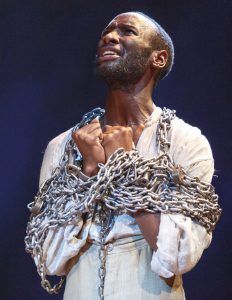
Working with a small canvas—only two actors, one of whom plays two roles—Davis paints a portrait of a prophet of sorts. (The Biblical overtone suggested by the title is appropriate to the play, although the Jerusalem was in Virginia, where Turner was hanged.) Davis’s protagonist is a generally mild-mannered former preacher, as the historical Turner was; he had been taught to read the Bible, but not allowed to read anything else. He became a pastor to the slaves, and a leader. During a monthlong uprising that he led beginning in August 1831, he managed to enlist other slaves to his cause, and they killed 12 men, 19 women and 24 children. Davis makes it clear that the deaths of the last were horrifying and inexcusable—one child was thrown headless into a fireplace to burn.
In spite of Davis’s early forthrightness about the horrors Turner perpetrated, the character, played with passion and philosophical nuance by Phillip James Brannon, gradually emerges as something of an Old Testament prophet of vengeance, imbued with a righteousness that some may find uncomfortable. It is perhaps the only way Turner’s story can be made understandable and receive any feeling akin to empathy, but it’s a subtle canonization at odds with his butchery.
There are intimations of the New Testament as well, as if Turner is also Christ-like. His chronicler Thomas Gray, whom Turner calls “Doubting Thomas,” refers to an episode “wherein you claim…to have spent thirty days alone in the wilderness.” The dual-edged reference is to Turner’s escaping capture for a month as much as to Christ’s 30 days in the wilderness. The Guard (Rowan Vickers plays both, but fares better as the Guard) shares bread with Turner. And echoes of Peter denying Christ arise in the Guard’s attempt to backpedal from a commitment he made to attend Turner’s hanging so the prisoner will spy a friendly face. (Davis’s notion that blacks will attend the hanging is a miscalculation, surely; given the recent slaughter of blacks in retaliation, it’s a stretch to believe they would gather at the gallows or that the white populace would permit them to assemble at such an incendiary event.)
The duologues Davis has devised between Turner and his two visitors are engaging and often eloquent. Turner declares, “It is Negro women, servants in wealthy houses who feed and nurture children like your daughter. Women whose own children may be snatched from them at any time and sent God knows where.”
Yet occasional moments ring false. Gray, considering a whale-oil lamp, says he feels “melancholy for the whales.... Sometimes I worry that there’s a limit. That one day there won’t be any whales left.” The sentiment might have been lifted from a recent Sierra Club press release on global warming. An example of Turner’s wit is also awkward. “Few men aspire to be the guards of prisoners,” he tells Gray in reporting a conversation with his guard. “It is little better than being a prisoner oneself. I said to one of the guards the other day, ‘Which one of us is on the wrong side of the bars? Which one of us is the real captive?’” It’s a sentiment that might be drawn from 1960s movies like King of Hearts or Cool Hand Luke.
Credibility aside, the production by Megan Sandberg-Zakian is deftly pared down and engaging, and Davis’s poetic language is given full weight. The only décor of the play, which is staged in traverse, is two large abstract paintings in gray and black, with hints of dull yellow and blue, and a platform that moves, scene by scene, from one side of the central stage to the other (the scenic design is by Susan Zeeman Rogers). An irritating loud-rock score (sound is by Nathan Leigh), akin to the pounding noise Neil LaBute used in The Shape of Things (2001), will drive you batty if you arrive too early—that is to say, more than 30 seconds before the play begins. At least what follows is, with whatever flaws it has, much more palatable.
Nat Turner in Jerusalem runs through Oct. 16 at the New York Theatre Workshop (79 E. 4th St.). Evening performances are at 7 p.m. Tuesday, Wednesday and Sunday; and at 8 p.m. Thursday, Friday and Saturday. Matinee performances are at 2 p.m. Saturday and Sunday. Tickets cost $69. Tickets may be purchased by calling 212-460-5475 or visiting nytw.org.
Cirque Ex Machina
Inside Cirque Du Soleil’s trademark blue-and-yellow big top, a stream of dusty golden light fills the tent, like so many metallic birds flitting above our heads. It seems the perfect setting for this Quebec-based nouveau cirque’s foray into the Victorian age, in a production engagingly titled Kurios: Cabinet of Curiosities. Written and directed by Michel Laprise, the show on Randall’s Island retrofits modernity with a captivating, old-age charm. The effect is transportive; the assorted delights of fishlike contortionists, aerialists and a hugely entertaining live band, prove just enough to take the audience on a trip well worth remembering.
Aboveground Racial Politics
Underground Railroad Game, a bold and imaginative theatrical piece created by Jennifer Kidwell and Scott Sheppard, is a bawdy satire in which the audience is made to look head-on at the serious issues of race, sexuality, and how we deal with them in the aftermath of slavery. Guided by a thoughtful director, Taibi Magar, the piece exposes the damage that has been done to the national psyche by slavery’s devastating legacy, especially in terms of interracial relationships and the ways we communicate.
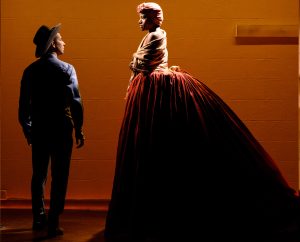
Two teachers—Caroline (Kidwell), an African American woman, and Stuart (Sheppard), a white man, are teaching a fifth-grade class project on the Civil War. Dressed as a Quaker abolitionist, Stuart aids a distressed runaway (Kidwell) in a campy tête-à-tête that establishes the sexual energy between the two characters immediately. Then the action abruptly changes to the bright, fluorescent-filled modern classroom where the two are enthusiastically teaching the issues of the Civil War. The teachers quickly include the “class” (i.e. the audience) in the “games” of war, incorporating “safehouse signs” and “slave dolls.” Soon the battle of the sexes is added to the mix, as well as interracial relationships, as the teachers spend time together outside the classroom.
Kidwell as Caroline gives a raw, bold, yet vulnerable interpretation of the African-American woman and her torn relationship with white men. Sheppard’s comical yet painfully exposed performance as Stuart breaks through serious barriers that society doesn’t often discuss. Sheppard and Kidwell’s dramatic exposition feels especially relevant with the racial tensions in the U.S. right now. Magar’s choices as director show the negative effects of slavery’s legacy and the way it has stunted the nation’s ability to heal through open and honest discourse.
The authors use stereotypes of African-American women from old movies such as Gone with the Wind, yet Magar has invested the piece with both melodramatic flair and honesty. Particularly riveting is a segment when Caroline is dressed in Mammy costume in daguerreotype silhouette. As Kidwell plays the runaway slave hiding in the barn, her blood-red, antebellum skirt is the focus as the character sensually moves her arms and upper body in beautiful rhythm with her song that draws Sheppard’s abolitionist to her breast. They offer a tender, painful look at the two characters’ complicated sexual relationship as a result of the shackles of enslavement. Kidwell seductively pulls her skirt up and Sheppard kneels down to her, disappearing in the velvet billows. The skirt eventually becomes a pup tent where the two teachers are discussing social issues and their relationship, foreshadowing the theme of the power of language and the bruises of misunderstanding because of white privilege.
The designers contribute sinister fog, dogs barking, creaking barn doors, crickets, and bobwhites chirping (sound design is by Mikaal Sulaiman) in the distance.
Kidwell and Sheppard have been working on this piece since they met as teachers several years ago; it is produced with the Philadelphia-based troupe Lightning Rod Special. Through the period story, they carefully expose the sexually charged, precarious relationship between African-American women and white men in this country today.
Magar guides them through some volatile moments: triggered by Stuart’s response to the phrase “nigger lover” in a classroom prank, Miss Caroline rears up in righteous indignation into a fiery S&M dance with him that is not for the prudish nor for small children. The two rage against their attraction for each other and the forces that pull them apart, leaving Teacher Stuart completely bare on stage, both physically and emotionally, and Kidwell takes Sheppard to school in an S&M dance that leaves him completely exposed, revealing a sinister essence at the core of their relationship. The play ends with both standing barren and disconnected. But with that, it is clear that only through empathy and open discussion, can we heal from our history’s wounds.
Although the past has left its ugly mark, Underground Railroad Games challenges us to look at our past with honesty and move ahead to a positive future.
Underground Railroad Game plays at Ars Nova (511 West 54th St.) through Nov. 11. Performances are at 7 p.m. Mon.-Wed. and at 8 p.m. Thurs.-Sat.; matinees are at 3 p.m. Saturdays. Tickets are $35; for more information, visit arsnovanyc.com or call (212) 352-3101.
Tortured Souls
Marta Mondelli’s Toscana, or What I Remember begins as the story of two couples whose lives intersect at a hotel in Tuscany in the middle of February. Each is tortured in his or her own right. It starts interestingly enough with Emma (Mondelli herself), an Italian who has been living in New York, and her husband, Fred (Scott Barton), who is paralyzed from the waist down and confined to a wheelchair. To say they annoy each other is an understatement. Emma, who often hears a little girl singing and playing, is neurotic, bitter, and foul-mouthed. If she loves Fred, it’s hard to tell. “All of a sudden he gets in this stupid chair, and I have to carry him around like a baby in a stroller,” she complains.
The second couple, “Sue and Larry Cole from Wisconsin,” played by Nicole Kontolefa and Lance Olds, add a bit of lightness to the play initially, but not for long. Larry is a botanist visiting Italy for a conference, while the pregnant Sue annoys him by frequently apologizing to him. He detests the phrase “I’m sorry” so much that she ends up apologizing repeatedly, a gag that should have been funny. Though not as unpleasant as Emma and Fred are to each other, the Coles are wound tight. Sue becomes a little unnerved that she’s forgotten her sunblock—even though it’s 50 degrees in February! Larry is concerned about his speech at the conference. “Hopefully, no one will scream at me today,” he says. “Plant scientists are so conservative.” The typical Midwestern characters are written in a way that suggests it’s their first trip abroad.
Kontolefa, however, exhibits a range of emotion. She begins as an awkward young wife, concerned about her pregnancy. But her Sue is either afraid of Larry or afraid of losing him. When confronted with the possibility that her husband and Emma may have kissed, she displays a strength that shows a depth of character, losing any previous hints of schoolgirl silliness.
Director Tara Elliott keeps things moving along smoothly. However, she was not able to elicit from the actors the subtleties necessary to portray Fred and Emma convincingly. Playwright Mondelli was unable to flip the switch from neurotic and mean-spirited to loving and doting for the bipolar Emma. Barton was only able to move off the emotion of exasperation when he had dialogue with Sue about her pregnancy.
Furthermore, Mondelli’s script is underdeveloped. Too many times the conversations come off as inane cocktail conversation and unnervingly repetitive. Emma asks Sue, “How far along are you?” and she replies, “Ten weeks.” Emma retorts, “How many months is that?” Or Larry’s insipid argument that plants don’t respond to music but yet “they communicate to each other through electricity.” When Sue wants to push Fred in his wheelchair, Larry interjects, “Sue, you’re weak.” No, she’s pregnant; since it’s already been revealed that he’s been through one pregnancy with his first wife, why would he jump to “weak” when there is nothing in the script to suggest it?
On the other hand, there are elements that complicate the story that Mondelli leaves undeveloped. For instance, there’s the recurring sound of a child singing offstage—while appropriate to hear the child singing before the play begins, which sets the tone, it makes little sense during the play for the audience to hear the child, given a turn of events late in the production. Although Emma repeatedly swears at the child, which paints her as callous, there’s a persuasive twist that comes too late to redeem her.
Oddly, there is something to Toscana, which is probably what brought it to the stage in the first place. However, it wasn’t nurtured and developed to its full potential, which can happen when the playwright is also cast as the lead. Surprisingly, after all that, the play resonated more the next day than immediately after. Maybe the dust had to settle on too much unfinished, stilted dialogue to get to the heart of Toscana in the moment.
Toscana, or What I Remember is at Cherry Lane Studio (38 Commerce St. in Greenwich Village) through Oct. 1. Performances are at 7 p.m., Tuesday-Saturday; Matinees are at 2 p.m. Sept. 25 and 3 p.m. Oct. 1. Tickets are $18 general admission and $15 for students/seniors. For tickets, go to https://web.ovationtix.com/trs/pr/963985. For more information, visit toscanaorwhatiremember.com.
Young But Wise
Shelagh Delaney was only 18 when her first play, A Taste of Honey, premiered in London in 1958 and she added to the gender diversity of the Angry Young Men of postwar British theater. The play was developed at the acclaimed producer Joan Littlewood’s Theatre Workshop, and it contains some of Littlewood’s hallmarks, notably a jazz trio playing standards that evokes the British music hall (a popular influence in British theater, used by John Osborne as the setting for The Entertainer and by Littlewood herself in Oh, What a Lovely War!—and on through Privates on Parade, right up to One Man, Two Guv’nors in 2011).
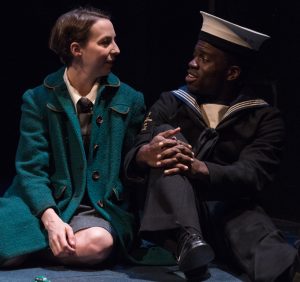
As with Osborne, Arnold Wesker, and John Arden, the focus of the “angry theater” was the travails of the working-class English. Delaney’s play is set in Manchester, and concerns Jo, who is 17 and lives with her mother, Helen (Rachel Botchan), a sometime prostitute. For the late 1950s, and for an author of 18, A Taste of Honey is astonishingly frank and casual about taboo topics of the period. Jo refers diffidently to Helen’s “immoral earnings.” Jo herself has an affair with a black sailor (Ade Otukoya) and becomes pregnant by him. She sets up house with a fellow art student, Geoffrey (John Evans Reese), who is gay and has more nurturing instincts toward her than Helen does.
Jo’s fractious relationship with her mother is, in Delaney’s play, the fault of both characters. Rebekah Brockman’s Jo is irritatingly immature and impractical, yet self-confident, and she and Helen squabble frequently. Helen has clearly not taken a strong hand in raising her daughter, and Jo is a free spirit as a result, mouthing off in a way that the vast majority of middle-class 1950s teenagers probably wouldn’t dare to.
Meanwhile, the narcissistic Helen blows hot and cold about caring for her daughter. “Why don’t you learn from my mistakes?” she asks Jo solicitously at one point. “It takes half a life to learn from your own.” Yet she’s also capable of saying, “I never have thought about you when I’ve been happy.” It’s a measure of Delaney’s maturity that she can create characters so complex and show the struggles of their lives so vividly.
The play focuses on Jo’s coming of age. Helen has a roistering time with a former client/boyfriend named Smith (Bradford Cover, with an eyepatch), who has tracked her to their new digs. Joe resents Smith and spars with him verbally, even though he makes overtures to be kind to her. (In The Angry Theatre, John Russell Taylor, who saw Delaney’s original script, says Smith’s kindness was toned down in Littlewood’s final version.) Eventually Helen runs off with him, only returning after Smith has run off with a younger woman. Meanwhile, Jo and Geoff have established a home of a sort—Jo works in a shoe shop by day and a bar at night. But Botchan’s selfish, blundering Helen, now displaced, ousts Evans’s gentle, patient Geoff in the awkward, melancholy climax.
The play is a dream play, with flights of fancy and high theatricality in spite of its working-class milieu—Jo talks about the sailor being “an African prince,” and Geoffrey yearns to be a father figure in a heterosexual family and fit in. Characters deliver asides to the audience in the manner of Restoration comedy. Director Austin Pendleton uses the jazz trio not only to punctuate verses of songs that the characters break into, and to cover scene changes, but also as a silent chorus. When Helen shows them racy advertisements, Max Boiko (trumpet), Walter Stinson (bass), and Phil Faconti (guitar) play along and take a look with wry reactions; two of them often share the sofa with the speaking characters. (Harry Feiner’s scenic design delivers a heavier dose of realism, with its drab browns, duns and mustards, visually enlivened only by Barbara A. Bell’s bright dresses for Helen.)
Still, there’s a sense that, even with its open artifice, Delaney’s characters were lifted out of a vacuum and placed in this setting. As a dream play, it’s not as easy to adjust to or as persuasive as, say, The Glass Menagerie. Delaney never had a bigger success than A Taste of Honey, and it’s rarely revived nowadays. It has perhaps frayed a bit at the edges, but it’s still a work that continually surprises with its modern feel. The Pearl Theatre’s season opener is a welcome opportunity to see it.
The Pearl Theatre's production of A Taste of Honey will play through Oct. 30 at 555 W. 42nd St. Performances are at 7 p.m. on Sept. 20, 22, Oct. 3, 4, 10, 12, 13, 16, 20 and 24; at 8 p.m. Sept. 23, 24, Oct. 21, 22, and 29; and at 2 p.m. Oct. 2, 22, 23, and 30. Tickets are $59 and may be purchased by calling the theater at (212) 563-9261 or visiting pearltheatre.org.
Looking for God and Love
Serious pianists love to study the great composers in order to explore and channel the music they are to perform. Hershey Felder, the writer and star of the solo show Maestro, is a serious pianist and composer in his own right. He is also a gifted and highly successful singer, director, and producer. His one-man show is the natural rumination of one serious musician about another.

Maestro is the story of the larger-than-life phenomenon that was Leonard Bernstein: conductor of the celebrated New York Philharmonic and orchestras worldwide; the second most performed classical composer in the United States, who also wrote the scores for the hit West Side Story and other Broadway shows; the creator of 53 Young People’s Concerts and proselytizer on behalf of the classical music tradition to the millions he reached on TV and in lectures all over the world. In this and other plays, Felder has created a piece of biographical theater. His one-man plays about Gershwin, Chopin, Beethoven, Liszt, Irving Berlin, and now Bernstein, use story, song, and music to probe the lives of great musicians and deepen our understanding of music itself.
Bernstein’s overarching passion was to compose. In Lenny’s voice, Felder explains what lies behind the works he composes: “and in every one of these pieces, I am busy looking for God. And for love. Because as composers, that’s what we’re always doing.” This desire, the desire to compose and all it encompasses, is the spine of Felder’s play. Will Bernstein find God? Will he find love? Will he write the great works he so badly wants to write?
Felder takes on Lenny, the controversies about his life and his music, and looks for the truth behind the noise of his fame. He shows us a man whose betrayal of his marriage and loss of his wife to cancer upended his life. And he shows us a man who, for all of his achievements as a composer, was never embraced by the classical composing establishment, which rigidly favored atonalism. Bernstein not only believed that tonality and melody were at the heart of all great classical music, he wrote successful musicals; brought classical impulses into his popular music; brought popular idioms into his serious classical compositions; and was just too populist in every way to win the seal of approval of that elite club whose tenets he rejected. He paid a heavy price.
Beautifully directed by Joel Zwick, the work uses projection and lighting (Christopher Ashe) as well as audio (Eric Carstensen) in striking, even brilliant ways. Does Felder do justice to Bernstein? Do we know the man more deeply after the play than we did before? These are questions that theatergoers will answer for themselves. But in bringing us a character whose passion and achievements were in music, Felder’s own musicianship, his teaching moments riffing on music that occur throughout the play, and his prowess at the keyboard, bring us more deeply into the soul of Bernstein than this genre might have otherwise permitted.
A solo show is a special feat for any actor. Maestro runs one hour and 45 minutes and includes challenging work at the keyboard, some of it while also singing or speaking. At the same time, is it mean-spirited to say there is a bit too much West Side Story and that, if the final song were cut, the play would end on the more tragic note intended by Felder, without sentimentality? Interestingly, as a baritone, Felder sings in a soft and lilting popular style and also in a steelier, more trained classical style, sometimes combining both, just as Bernstein was forever migrating from one style to the next in unexpected ways. Vocally this usually works—but not always.
Did Bernstein find God and love in his composing and in his life? In the most powerful moment at the end of the play—better experienced than described here—Bernstein combatively turns and asks questions of the audience. Then he recites a poem Bernstein wrote in which he sums up how he views his life in the face of his approaching death. Did Bernstein find God and love in his composing? No, Felder says, not in Bernstein’s eyes. And yes, Felder says, in the eyes and hearts of all of us who listen to his story and, even more important, to the maverick genius and passionate heart of the music that beats beneath it.
Maestro runs through Oct. 23 at 59E59 Theaters (59 E. 59th St.). Evening performances are at 7 p.m. Tues.–Thurs. and at 8 p.m. Friday and Saturday; matinees are at 2 p.m. Saturday and 3 p.m. Sunday. (Additional performances are at 2 p.m. Sept. 29 and Oct. 13. There are no performances on Sept. 24 or Oct. 11 or at 7 p.m. Oct. 2.) Tickets are $25–$70. For more information, call Ticket Central at (212) 279-4200 or visit www.59e59.org.
Feathered Enemies
The Birds, Conor McPherson’s creepy new play, is derived neither from Aristophanes nor Alfred Hitchcock. It does, however, share DNA with the 1963 film because both draw from a short story by Daphne du Maurier. (Hitchcock also used du Maurier novels as source material for Jamaica Inn and his Oscar-winning Rebecca.) Don’t expect to find real birds or even simulated ones in the pocket drama at 59E59 Theaters. Fans of the movie won’t find a pompous female ornithologist with environmental concerns or a schoolteacher with her eyes pecked out either.
That Pharmaceutical Connection
The drug that gives Ana Nogueira’s new play its name, Empathitrax, fosters complete intimacy between two people in a relationship. The users take it with water, then wait a bit and touch each other—waves of empathy ensue as the feelings of the other become utterly accessible. It’s apparent almost immediately that the man and woman in Empathitrax—Nogueira’s script identifies them only as Him and Her—need artificial stimulation. As they meet with a delivery guy from Empath in their minimalist living room to discuss dosages and procedures, they interrupt themselves, grasp at each other awkwardly, smile uncomfortably and generally broadcast that their relationship is strong but that there might be some problems.
Nogueira develops her theme carefully. Focusing on a drug that interferes with one’s natural personality traits is not a fresh topic—Placebo and The Effect have been there—but Nogueira’s play is still a strong entry in a subgenre of modern drama. It allows its actors to work with a wide range of emotions. And those actors—Jimmi Simpson and Justine Lupe as Him and Her, and Genesis Oliver, who doubles as the Empath delivery man and as Him’s buddy Matty D.—give astonishingly good performances, not just charting the emotions unleashed by the drug, but investing the science-fiction aspect of the story with credibility. As they undergo the effects of Empathitrax, they touch each other and each feels what the other is feeling. The physical empathy they enact is persuasive and overpowering.
Simpson once starred on Broadway in The Farnsworth Invention and looked set to be a fixture in the theater, but forsook it for television work. He was clearly an actor of great gifts, and they have not diminished. He uses every second of stage time, much like Vanessa Redgrave, to create a pointillist portrait. One is afraid to look away for fear of missing the tiniest apt grimace, deep breath, or shoulder shift that conveys crucial information.
If Him is calm, rational, giving and patient with his partner to a fault in their daily lives, Her can still push his buttons at times. She buys a bed they cannot afford without consulting him, and that provokes exasperation. But every interaction, every hesitation, every flash of emotion between Simpson and Lupe is precisely evoked under Adrienne Campbell-Holt’s superb direction.
Lupe’s Her is needy and insecure, and although the opening scene with the delivery man plays like a Cowardian comedy of manners, things turn darker. “This play is a comedy, until it’s not,” reads a direction in the script. And it’s quite funny for awhile, as Him subsequently meets with his buddy Matty on the rooftop to vape and describe his experience with the drug. “I guess that I didn’t know how much the little things mattered to her and she, she didn’t realize just how much I cared about her,” he says. “But now we can actually show each other, transfer the information. It’s quick and it’s potent.”
Matty tries to relate every emotion to a past drug experience: “So it’s like doing Molly?” he asks. “So like, a Xanax.” He’s an expert on artificial stimulants, but, in a scene at a party with Her, he reveals that his impetus to using drugs may well be a result of his sick father: “He’s like, almost catatonic, all the shit they have him on. It’s keeping him alive which is good, I guess. But.” To which Her responds: “But what’s the point of being alive if you aren’t really taking it all in.”
It’s a modern dilemma—the desire to experience everything. Even the rampaging use of the Internet to see life in all corners of the earth, to miss nothing, to signpost one’s existence for others to notice, is a symptom. Her tries to finesse the shortcomings of her relationship with him by adopting a dog, Rufus, who is kept in a crate and sometimes barks and sometimes is heard chewing on treats (the sound design is by Matt Otto). Rufus’s unconditional love cheers her, and Lupe has a couple monologues with the dog, in which she displays her neediness: “Do you like me even a little? Do you realize I saved your life? No one in the world knows what could have happened to you if you stayed in that shelter.”
In Nogueira’s satisfying ending, well grounded but still a surprise, the author comes down on the side of natural experience rather than chemically induced effects. Simpson’s Him does something uncharacteristic—he improvises—and the delicacy and romance of the final moments pull the play back from the darkness enveloping it. It’s no longer a comedy gone awry.
Colt Coeur's production of Empathitrax plays at HERE Arts Center (145 Sixth Ave., entrance on Dominick Street) through Oct. 1. Evening performances are at 8:30 p.m. Thursday through Saturday, and 7 p.m. Sundays and on Monday, Sept. 26. There is also a matinee at 4 p.m. on Oct. 1. Tickets are $18 and may be purchased by visiting here.org.











